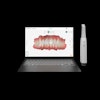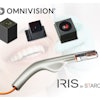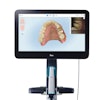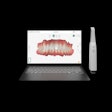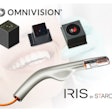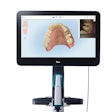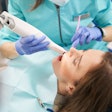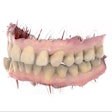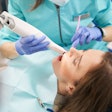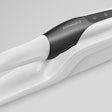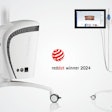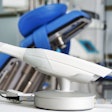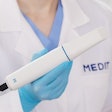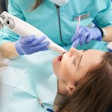Digital scanning is no longer a luxury reserved for large, high-tech practices -- it has become an essential tool for modern restorative workflows. Whether capturing a single crown preparation, designing aligners, or scanning a full arch for prosthetics, intraoral scanners have steadily replaced traditional impressions in everyday dentistry.
Yet in 2025, one major barrier remains: cost. Many established systems, such as iTero, CEREC, 3Shape, and Medit, can carry price tags that rival a small car lease, placing them out of reach for many practices that want to modernize without breaking their budgets.
 Dr. Ben Alvarez.
Dr. Ben Alvarez.
The Panda Scanner is designed to bridge that gap. Compact, lightweight, and priced at roughly $10,000 (plus $2,500 for the laptop), it presents itself as a cost-effective entry point into digital scanning without sacrificing accuracy or speed. In fact, its streamlined body -- smaller than an electric toothbrush -- makes it particularly well suited for pediatric, orthodontic, or geriatric cases where a limited opening often creates challenges. Combined with straightforward software that minimizes the learning curve, the scanner sets out to prove that digital workflows can be both clinically reliable and economically practical.
Of course, claims of affordability and ease must be matched by real-world performance. That’s why the Panda Scanner was evaluated by a group of Catapult clinicians, each with extensive experience using competitive scanners. Their candid feedback helps answer a central question for today’s dentist: Can digital scanning in 2025 truly be cost-effective, accurate, and patient-friendly?
Evaluation findings
 The Panda 3D digital intraoral scanner.Freqty Technology.
The Panda 3D digital intraoral scanner.Freqty Technology.
All evaluators found the Panda Scanner easy to learn, with 80% rating it "very easy" for both novice and experienced users, and the remaining 20% still finding it straightforward.
One dentist summed it up simply: "It runs through pretty quickly and can get a full arch in efficient time." The clarity of images was a standout, with 60% rating the scans as "exceptionally clear" and the rest as "very clear."
Margins and interproximal areas were captured with high reliability: Forty percent rated it as "extremely accurate," 40% as "very accurate," and only one evaluator suggested modest room for improvement.
Performance held steady even in complex cases -- 100% of evaluators rated it "very well" or "exceptionally well" on challenging anatomy, building real confidence when case difficulty escalates. Eighty percent of evaluators reported the scanner fit smoothly into their practice workflows with only minor adjustments, while 20% said it integrated seamlessly.
Compatibility with labs and CAD/CAM systems was generally positive but flagged as an area for refinement, with several evaluators noting the need for more universal bridging software. The design also drew consistent praise: Evaluators compared its size to that of an electric toothbrush, making it more comfortable for children, teens, and adults with a limited mouth opening, and a bit easier on dentists’ patience, too.
Sixty percent rated the tip as "extremely comfortable," 20% as "very comfortable," and 20% as "somewhat comfortable." At approximately $10,000 plus $2,500 for the laptop, every evaluator rated the scanner’s cost-to-value ratio as "very reasonable." Considering that its image quality and accuracy were often compared to scanners costing two to five times more, the economic argument is compelling.
Taken together, the findings highlight that the Panda Scanner offers not only strong clinical performance but also practical value. With that foundation, it is worth looking more closely at how the scanner performed in everyday practice.
Clinical performance
From a practical standpoint, the Panda Scanner consistently delivered reliable full-arch scans in under two minutes. That’s faster than it takes most patients to finish explaining why the crown came off -- for the third time this year. The simplicity of its software, often described as “basic,” was seen as both a benefit for quick training and a potential area for future upgrades (think model-builder functions or multibite scans). Basic, yes, but then again, so is black coffee, and most of us couldn’t get through a day without it.
What’s easy to overlook when evaluating scanners isn’t just image quality or scan speed, it’s how well the device stands up to everyday practice demands. A scanner isn’t judged only on a demo, it’s judged on how it flows between patients, assistants, and operators.
The Panda Scanner addresses this with autoclavable tips that are ergonomic and simple to maintain. This design supports efficient transfer between patients while meeting high sterility standards -- which is critical in today’s infection-control environment. The ability to quickly sterilize and reuse tips means chairside transitions stay smooth without bottlenecks.
And then there’s the cost. Unlike some systems that require single-use tips (a clever way to nickel and dime you per patient), Panda’s tips are built for repeated use over their service life. This balance of durability and sterility reduces ongoing expenses and adds to the scanner’s overall value proposition. It’s a reminder that Panda isn’t just about performance; it’s also about practicality, making digital workflows more efficient and more affordable for real-world practices.
Case review
While numbers and percentages are important, what often matters most is how a scanner performs in the chair with real patients. Here are two cases from my practice that highlight how the Panda Scanner handled both challenging and routine dentistry.
Case 1: Upper denture with multiple challenges
A female patient presented for an upper denture consult. She was completely edentulous and carried the perfect storm of complicating factors: limited opening, flat palate, atrophic ridge, and a strong gag reflex. In other words, the kind of recipe that usually spells disaster, or at least a quick referral to your favorite prosthodontist while you quietly thank them for existing.
Instead, we scanned her upper arch using both my Primescan (Dentsply Sirona) and the Panda Scanner (Figure 1). To no surprise, the patient much preferred the Panda. The smaller size and quicker scan -- just a couple of minutes even on tissue -- was far less intimidating than the “big scanner.” For a patient with a gag reflex, this can mean the difference between a smooth appointment and a clinical workout in chairside yoga poses.
 Figure 1.Images courtesy of Dr. Ben Alvarez/Catapult Education.
Figure 1.Images courtesy of Dr. Ben Alvarez/Catapult Education.
We also scanned her centric bite tray (Figure 2) and combined it with UTS CAD Facebow (Ivoclar) records for the lab. The lab found both scans accurate and free from inconsistencies, and the final denture was fabricated from the Panda data.
Despite her case having all the usual red flags, the fit was excellent, reminding us that accuracy in scanning and digital fabrication can turn what normally feels like a referral-worthy nightmare into a very manageable success story.
 Figure 2.
Figure 2.
Case 2: Routine replacement of a missing lateral with a fixed partial denture
The second case was far more typical: replacement of a missing lateral incisor with a fixed partial denture. What made this case noteworthy wasn’t the clinical challenge, but the workflow.
My Primescan was already in use with another patient, but with the Panda Scanner available, we were able to prep, scan both arches in just a few minutes, and keep the day on schedule without bottlenecks (Figures 3-5).
 Figure 3.
Figure 3.
 Figure 4.
Figure 4.
 Figure 5.
Figure 5.
This case illustrates why I consider the Panda a home run for everyday practice. It gives us another reliable option to keep patients moving, reduce downtime, and avoid major capital costs without compromising quality or accuracy.
Conclusion
The Panda Scanner impressed our evaluators with its ease of use, accuracy, and cost-effectiveness. While there is room for software refinements and expanded lab compatibility, the scanner’s strengths far outweigh these minor considerations.
What makes the Panda Scanner particularly noteworthy in 2025 is how it balances affordability with reliable clinical results. In a marketplace often dominated by high-cost systems, it demonstrates that digital scanning can be accessible without compromise.
For practices hesitant to adopt intraoral scanning due to price or complexity, this device represents a practical solution that delivers both performance and value.
Given its consistent results, patient-friendly design, and strong value proposition, the Panda Scanner has met Catapult’s criteria and is awarded the Catapult Vote of Confidence -- a recognition that underscores its role in making digital dentistry more attainable for everyday practices.
To find out more about the Panda Scanner, contact Chris Shaw at [email protected] or the sales team at (469) 200-2866 for all North American sales and support.
Note: Hear more from Dr. Alvarez and his thoughts on the Panda Scanner below.
Dr. Ben Alvarez graduated from the University of Missouri - Kansas City College of Dentistry in 2014. Dr. Alvarez is a recognized fellow in the Academy of General Dentistry. He is actively involved with the Missouri Academy of General Dentistry and has served as a past board member as the continuing education/PACE coordinator. Dr. Alvarez enjoys lecturing on CAD/CAM, patient diagnosis, and cone-beam computed tomography. He is the owner of Artizan Dental Care in Marshfield, MO.
Catapult is a premier dental education company with over 21 years of experience in providing world-class continuing education, product reviews, and now savings opportunities through our buying group, Catapult Grow. Its esteemed Speaker Bureau and evaluator team lead all product and service reviews, with companies paying a fee with the understanding that the Vote of Confidence™ award is not guaranteed. Catapult delivers honest and unbiased feedback through thorough evaluations and surveys, often aiding companies in improving their offering prior to market release. Its commitment to dental excellence allows organization to work with a diverse range of clients, ensuring impartiality -- no favoritism, just constructive feedback. Visit CatapultEducation.com to learn more.
The comments and observations expressed herein do not necessarily reflect the opinions of DrBicuspid.com, nor should they be construed as an endorsement or admonishment of any particular idea, vendor, or organization.
